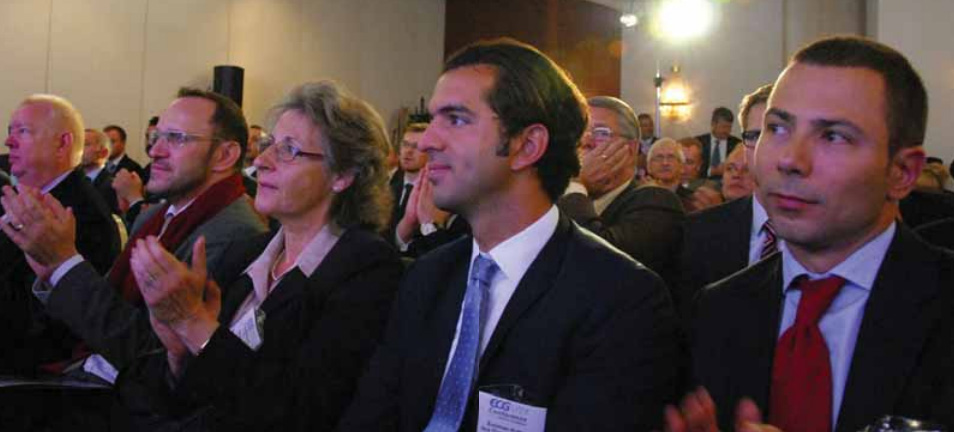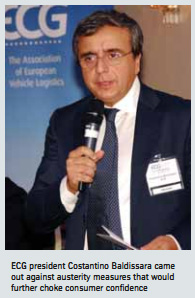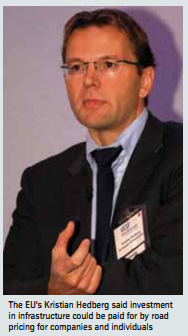
Europe’s fifth straight year of falling sales and drops in production have had significant impacts across the wider continent. We report from the ECG’s 2012 gathering.
The impact of the eurozone crisis on new vehicle sales was in full evidence when logistics providers met OEMs and policymakers at the ECG Conference this past autumn. With 2012 new passenger car registrations on pace to decline for the fifth straight year – to a low of 12.5m vehicles – and with no immediate economic recovery in sight, the talk was of yet more efficiency savings and for some – like transporter manufacturers – survival itself. “With no sales growth expected for 2013, we hope to have reached the bottom,” said Jan Maly, director of automotive consulting for PricewaterhouseCoopers (PwC). “We currently do not see EU sales recovering to the 2007 high of 16m units before 2018.”
Sales have declined across Western Europe but most dramatically in the south. The acuteness and length of the decline raises questions about the vehicle logistics sector’s ability to invest in new equipment, technology and services for a European automotive industry that is changing quickly. Geographic shifts in production and consumption, and the rise of new methods of car ownership and sales, make this “the most disruptive period to the automotive industry that we have ever seen,” said Ben Waller, senior researcher at the retail and distribution consultancy ICDP.
The president of the Association of European Vehicle Logistics (ECG), Costantino Baldissara, and its vice-president, Wolfgang Göbel, cited ongoing consolidation, mergers and bankruptcies in the vehicle logistics sector. Until recently these had been concentrated mostly among small providers, but recently the trend has been towards medium and large providers as well. “We’re beginning to see consolidation among European vehicle logistics providers, and there will certainly be more,” said Göbel.Referring to devastating macroeconomic conditions, Baldissara said the renewed crisis was “well above anything that could be done by LSPs or OEMs” and he came out hard against government austerity measures. “In parts of Europe right now the markets have dropped so low that if we don’t do something to help, [the industry there] won’t come back,” he said.
One such area appears to be among specialist manufacturers of car carrier transporters. According to Günther Percht of Kässbohrer Transport Technik, volume continues to be down 85% on the levels reached in 2008. “We are selling against the banks [which are disposing of vehicles returned from leases], not our competitors,” said Percht. Alberto Picco, sales director of Italy-based Rolfo, spoke bluntly: “We don’t know how long we can remain with this [level of] investment in the market. Our plants are dead. Tell us, can you [logistics providers] order some machines?”
Downstream cooperationWhile vehicle logistics operators can do little to influence the bigger economic picture, there were positive signs that co-operation within vehicle logistics has at least increased. Göbel claimed that carmakers had moved away from unilateral rate cuts even as the market headed down again.
“OEMs are done with rate cuts,” he told delegates. “They all did it during the last crisis, and most have realised that it won’t work anymore. Any further reduction would drive more providers out of business.”
One way the industry is promoting closer collaboration between OEMs and providers is through a joint communication platform between ACEA’s automotive logistics working group, and the ECG. “We believe downstream co-operation can provide benefits for both sides,” said Egon Christ, Daimler’s senior manager of worldwide transportation, who also spoke at the conference on behalf of the ACEA automotive logistics working group.
 “[ACEA and ECG uniting means] we now speak together with one voice to lift the potential for downstream benefits,” said Christ.Discussions between the groups are restricted to non-competitive issues, which means that contracts are off the agenda, as are issues such as fuel clause agreements. “A joint agreement on a standard fuel clause would improve things for everyone,” said Göbel. “But the legal advice is very firm – we can’t do it.” Progress has been made on standards, however, with ACEA now adopting ECG’s operations manuals for passenger cars and light commercial vehicles. Christ said that ACEA will also adopt ECG manuals for non-standard vehicles. Joint studies are being undertaken to analyse why and where empty mileage occurs, and the groups have also agreed to form a common approach for dealing with driver shortages and promoting innovation.
“[ACEA and ECG uniting means] we now speak together with one voice to lift the potential for downstream benefits,” said Christ.Discussions between the groups are restricted to non-competitive issues, which means that contracts are off the agenda, as are issues such as fuel clause agreements. “A joint agreement on a standard fuel clause would improve things for everyone,” said Göbel. “But the legal advice is very firm – we can’t do it.” Progress has been made on standards, however, with ACEA now adopting ECG’s operations manuals for passenger cars and light commercial vehicles. Christ said that ACEA will also adopt ECG manuals for non-standard vehicles. Joint studies are being undertaken to analyse why and where empty mileage occurs, and the groups have also agreed to form a common approach for dealing with driver shortages and promoting innovation.
Growth now all that counts in BrusselsDelegates also heard how economic troubles are leading to reforms in the European legislative environment for transport in a way that could have significant impacts for providers’ efficiency and cost base. Kristian Hedberg, head of the land transport policy unit within the mobility and transport section of the European Commission, reported that Brussels had in many ways become a “one-issue town”, with the renewal of growth dominating policy decisions. Next year is shaping up to be “the year of land transport,” said Hedberg, as the commission reviews policies ranging from the design of truck cabs, to the weights and measures allowed for trucking, and the easing of restrictions on cabotage (the rules which restrict trucking companies from operating in foreign markets).
A revision to the weights and measures directive could pave the way for the use of longer and heavier trucking equipment within member states as well as when crossing borders. The European Commission has already lifted cross-border restrictions on the use of the European Modular System – trucks with a length of 25.5 metres – between countries that have allowed their use. The ECG is also hoping that its call for a minimum allowable loading length of 20.75 metres will be met in place of the current patchwork, which would increase load factors without requiring any change to current equipment or infrastructure.
Changes to cabotage rules could help reduce empty mileage by allowing foreign trucking companies to operate longerin different markets, potentially capturing more volume for return loads. “It is a complicated issue,” Hedberg told delegates, “but doing nothing is not an option.” Hedberg said that changes could include extending the lifetime of cabotage operations from seven days to as long as six months. Other options are to lift restrictions but subject foreign operators to local labour laws. He also pointed to stricter enforcement of cabotage rules through the use of digital and satellite-connected tachographs to monitor truck movements in foreign countries.
Changing vehicle logistics flowsAmong the most pronounced impacts of market shifts has been an increasing imbalance between vehicle logistics flows for imports and exports. In Spain, for example, exports now outnumber imports by at least 3:1, according to Manuel Medina, vehicle distribution manager for SEAT – more than twice as much as in 2008. SEAT has dramatically changed its distribution flows and network as a consequence, including a shift in transport modes and distribution groupings. For example, SEAT previously used one logistics provider to serve a specific flow or country, but now relies on a more varied supplier base. There has been a significant shift to more truck and sea transport for the carmaker, with rail’s share dropping dramatically, driven by increased SEAT exports to Germany, the UK, China, but lower sales in Southern Europe.
Not including the shuttle from SEAT’s Martorell plant to the port of Barcelona, rail’s share of Seat distribution dropped from nearly 30% in 2009, to 15% in 2011 and is currently less than 7%. Rail’s share of exports from Spain, once more than 20%, is now around 3%, according to Medina. Sea transport, previously around 30%, has now reached more than 47% for SEAT, while truck has grown a little, from 40% of volume in 2008 to around 45% today.
However, the shift towards more sea has led SEAT to nearly double the vehicle inventory held at the port of Barcelona, toaround 7,000 units. “This has come at a high cost for us, and dealing with that is currently our fight,” he said. But like much else in the currently divided European economy and automotive market, the experience of one market or company cannot be generalised across the sector. Göbel, who is also Mosolf ’s vice-president of marketing, noted a dramatic increase in rail transport for some flows, particulary for vehicles produced for export. About 85% of Daimler production out of Hungary, for example, is sent using rail. Mosolf is also moving a significant share of production out of Daimler’s plant in Sindelfingen by rail to Bremerhaven. Even though these rail cars come back empty, it is still available business, he said.
 Russian resurgence
Russian resurgence
Delegates were given an insight into markets on the edges of Europe in a session on the global perspective, which included reports from Turkey and Russia. In Russia the market is booming, w ith a forecast annual increase of around 10-15% to 3m light vehicle sales in 2012.
Decree 166 is driving local production, and though the country’s recent accession to the World Trade Organisation reduces tariff barriers to imports, it is being circumvented by the introduction of a scrapping charge on them. Kirill Petrunkin, chief executive of Autotechnoimport, noted that domestic production of foreign brands had doubled between 2008 and 2012 to 1.2m units, on a total market of similar size for both years. This has been at the expense of imports, reduced by 500,000 units to 1m, and a steady loss of market share by domestic OEMs.
Well-known constraints on road transport include the annual weight limit introduced during the spring thaw in April. This year it meant that car transporters could not move even if empty, because they exceeded the five-tonne allowance. Othergovernment restrictions follow from disputes with Poland, so that car deliveries from Germany must by carried all the way by either Russian or German transporters, with no use of Polish trailers in between. These problems on the road are contributing to what Petrunkin calls a “second birth” for rail transport in Russia, although it is still mainly concentrated for distances of 1,500km or longer.
Turkey moves into Europe’s top five
While exports from Turkey to Europe have recently declined, the Turkish outlook is positive, according to the supply chain director of Tofas Fiat, Altan Aytac. He said Turkey is about to overtake Spain as the fifth biggest market in Europe (excluding Russia) with forecast sales this year of 1.4m units (including commercial vehicles). Production has been between 1m-1.2m vehicles every year since 2006, except for the downturn year of 2009. Tofas, the biggest producer in Turkey, builds for Fiat, PSA and (since 2011) for Opel. Its plant, like those of Ford, Honda, Hyundai, Isuzu and Toyota in Turkey, is in the western Marmara region, closest to continental Europe, but much of the country’s economic growth is occurring in the east. The finished vehicle logistics challenges this presents include an absence of rail, and long road trips with no backhaul. The Turkish market is also strongly skewed towards sales in the last few months of the year, which means that the country’s 2,000 road transporters cannot cope during the peak periods but are severely under-used in the early months of the year. Nevertheless, the general climate for logistics in the country is improving, said Aytac. Government investment is at last arriving for rail, and Turkey’s ranking on the World Bank’s annual Logistics Performance Index has steadily improved, moving from 39th in the 2010 report to 27th this year.
Future trends
The final session of the conference looked to the future of European vehicle logistics. ICDP’s Waller pointed to declining car use in Western Europe and the rise of car-sharing schemes in many cities as signs that the entire ownership model of vehicles was changing. In future, European vehicle logistics companies might deliver substantially more to fleet customers as well as have more involvement in remarketing and de-fleeting, he said. The EC’s Hedberg warned that significantly more investment in transport infrastructure was needed for Europe. He pointed to a recent German government study that said the country had underinvested in its infrastructure by up to €50 billion ($65 billion). Meeting the costs of such investment across Europe will be increasingly difficult given current debt and economic woes. Furthermore, if more vehicles shifts towards hybrid or electric powertrains, as the EC expects, than countries would lose a source of financing from taxes on fuel. Hedberg pointed to road pricing as an answer. “Transport users, whether trucking companies or passenger car drivers, will increasingly be called on to pay for the use of infrastructure, in the same way that we pay for telecommunications or electricity networks,” he said.
Trickle-down innovation
Björn Klippel, managing founder of TIM Consult, a consultancy working across several different industries for logistics, thought practices used by other industries should “trickle down” to vehicle logistics. Among these were the decoupling of tractor units from the trailer. He pointed to intermodal equipment where a container can be shifted between ships, rail or road equipment, enabling modal and routing efficiencies without the limitations of driver shortage. “The use of such flexible equipment for outbound [vehicle] logistics is a big opportunity,” he said . Klippel also predicted that operational methods to decrease empty miles would become even moreimportant in future, a point made by Waller when he said that market volatility puts pressure on carmakers andlogistics providers to pool volumes by highlighting the dangers of suppliers failing to invest or innovate. Klippel warned that carmakers themselves might invest. “If no service appears, shippers could move into ‘horizontal collaboration’, where they might become operators themselves to some extent,” he said. “We’ve already seen that in some cases.” Noting the move the other way by GM, Klippel felt that its deal with Gefco could not be applied generally. “I don’t see the vehicle logistics industry moving towards 4PL or asset-light operators, since it would depend on their ability to guarantee the service and to improve on already very thin margins,” said Klippel. “Other industries are actually moving back towards asset-owning models.”However, there are questions over how much providers will be able to invest in equipment, new services and technology. As Klippel pointed out, recent advances in the sector have come when larger companies made investments in services that were previously considered inadequate, such as for rail. Waller and Klippel wondered whether there were any logistics providers willing now to make such moves. “Who is currently planning for the upturn?” asked Waller. “Where will the investment actually come from?” It’s a critical question that could remain unanswered until the region sees a way towards economic stability – by which time it might already be too late from providers to put forward the innovations the sector arguably needs immediately.

























![Global[1]](https://d3n5uof8vony13.cloudfront.net/Pictures/web/a/d/s/global1_726550.svgz)









